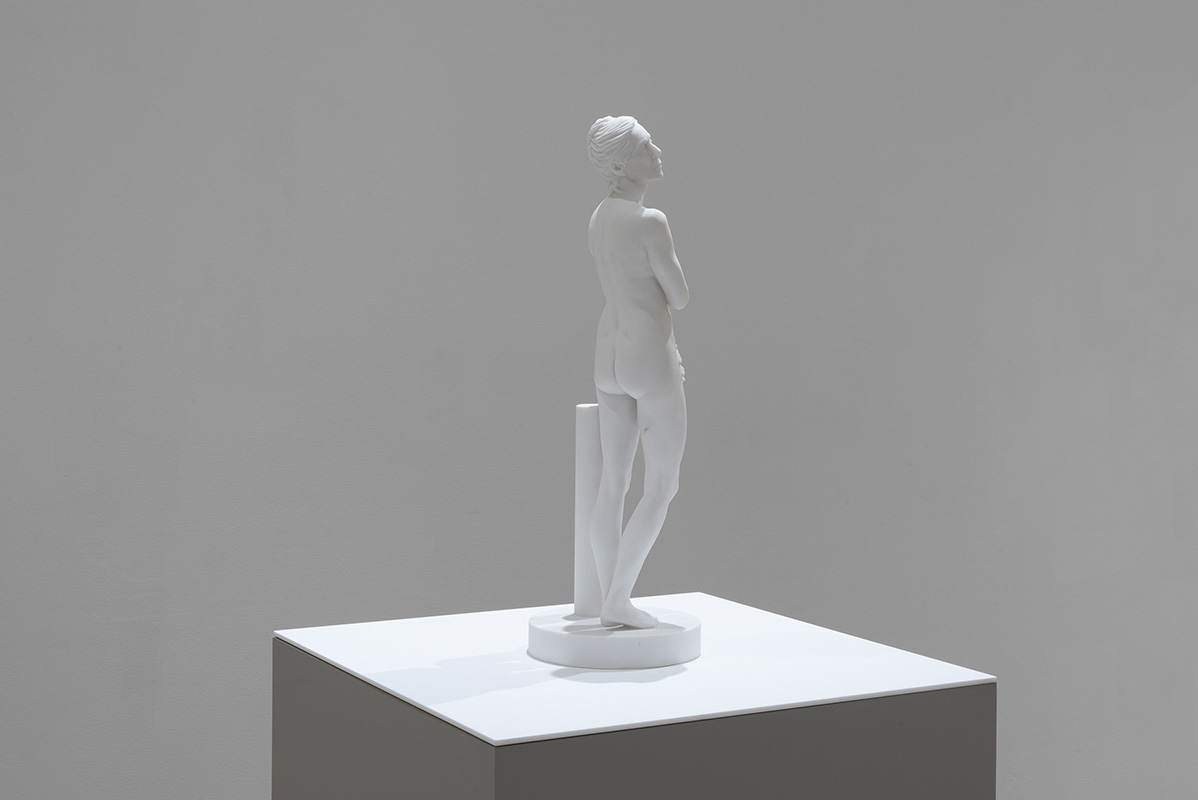
AGING VENUS, 2018
white Sivec marble
24” tall
My first marble sculpture was the culmination of a body of work titled, the self-portrait sessions. The foundation of this portrait series was built on mirroring (I literally sat in front of the mirror gazing at my own reflection and the image was constrained to this mirrored space—the mirror’s edges are never seen). The photographs themselves were indexical but they also adhered to an internal logic of indexicality (e.g. the image of the self outside the mirror pointing to the self inside and vice versa). The images were also iconic (e.g. depicting verisimilitude to me).
As the photographs accumulated over the course of a decade, I began to notice myself aging. Some of the images I shot in the mirror were sharper in the foreground space than in the mirror, and I began to see that second softer reflected self, which was less wrinkled and less flawed, as my idealized self. From there I decided to create a representation of an idealized older body. Marble seemed especially suitable because inherent in the material is an idealizing or smoothing of flaws that is part of the process of polishing.
AGING VENUS, is a contemporary iteration of classical sculpture using my aging body as a model. The preparation for the creation of this sculpture began with a 3D scan of my body, realized by photographing me on a small stage surrounded by cameras (called photogrammetry), and then stitching the parts together to make an object file. The sculpture was cut from white Sivec marble by a high performance robotised 3D scanner that cuts stone with laser technology. After the cutting was complete, I worked with a traditionally trained sculptor to help me finish and polish the marble. The sculpture stands 24” high.
Because the work is based on photogrammetry it retains an element of the indexical as well as an obvious iconic value (its likeness to me). At the same time, in order for the sculpture to be cut out of marble, information must be translated into data as an object file and then reprogrammed into software that recognizes the information as a model to be carved. This process, while completely data driven, does retain at least a ghost of the index. The data is reversed engineered back into a material likeness we can easily recognize.
The same object file used to create the sculpture, can be placed inside Maya and photographed as if it were a model, generating a set of 2D self-portraits, whose iconic value (resemblance) remains in tact, while its function as an index (what exactly it is referring to: me in the photogrammetry rig, the physical sculpture, the data file), becomes less certain. I have thought a lot about embodiment: in relation to aging, in relation to the social and psychological consequences of being marked by gender, and in relation to more recent conversations, initiated primarily by men, about discarding the body and uploading the brain to a computer to achieve immortality. I don’t believe that the mind and the body can be separated. As the modernist mind/body dichotomy and the male/female dichotomy (this one with far more resistance and backlash) disintegrate, aided by the fluidity of the digital, it becomes easier to create a seamless representation of the hybrid body, while at the same time retaining the indexicality based on photogrammetry as well as an obvious iconic value (a likeness to the two of us). As such, these sculptures and photographic portraits straddle the line between digital photography (and an indexical component that some deny to the digital) and post-photography or simulation technology, living in an ambiguous interstitial space.
AGING VENUS was first shown in the exhibition Out of Body: Sculpture Post-Photography, co-curated by Claudia Hart and myself with Stephanie Dinkins, Claudia Hart, Carla Gannis, Sophie Kahn and Susan Silas at bitforms gallery October 27th to December 1st, 2018. The sculpture then travelled to Wasserman Projects in Detroit for the group exhibition Portray, curated by Alison Wong from January 27- March 23, 2019.
(photo credit: Emile Askey)